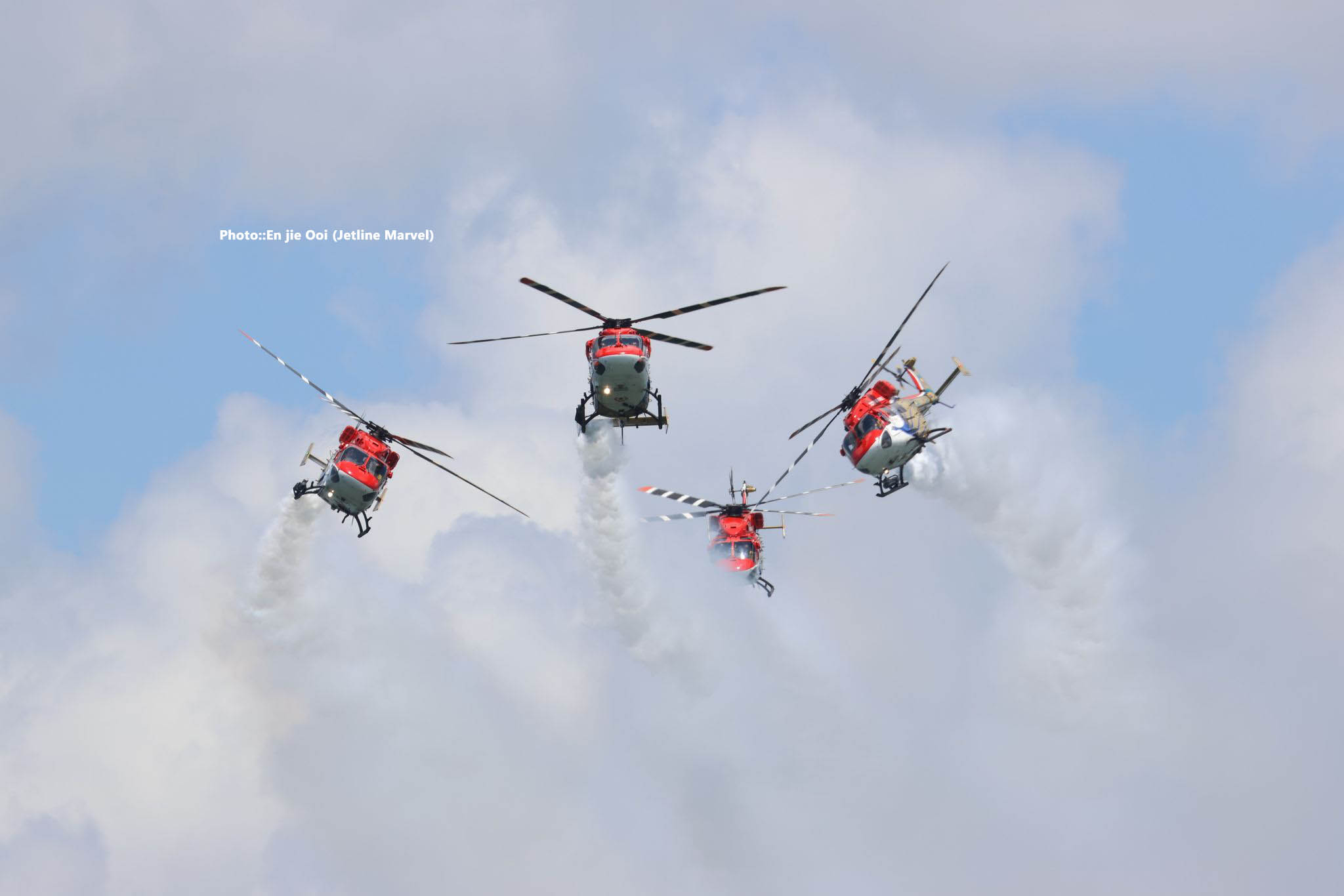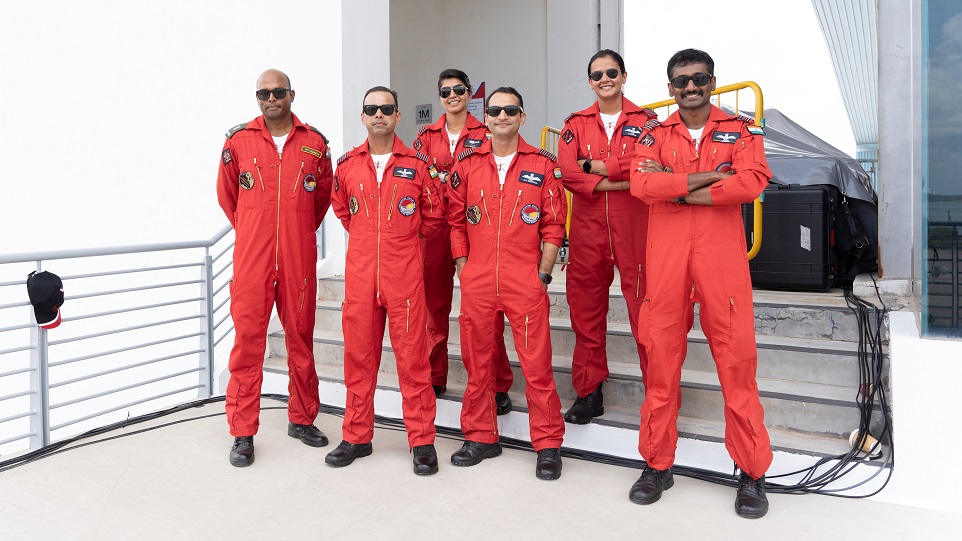Aviation
Exclusive Interview with the IAF Sarang Display Team at the Singapore Airshow by Jetline Marvel

In the heart of the electrifying atmosphere at the Singapore Airshow, where the roar of jet engines fills the air and the sky becomes a canvas for breathtaking maneuvers, Jetline Marvel had the distinct honor of engaging with the illustrious members of the Indian Air Force (IAF) Sarang Display Team. As a beacon of precision and artistry in aerial displays, the Sarang team’s performances have captured the imagination of audiences worldwide,
The Indian Air Force (IAF) Sarang Display Team is made up of 71 Personnel including 13 Pilots, 3 Engineering Officers, and 1 Commentator. We managed to catch up with a few crew members during the Singapore Airshow 2024 and asked them some questions to better understand their job scope.
Meet the Sarang Team: (From Left, Bottom Row) Major Chandan, Wing Commander Sridhar, Group Captain Mishra, Squadron Leader Akash. (From Left, Top Row) Flight Lieutenant Pallavi, Squadron Leader Shipra.
- 1. Tell us more about the history and heritage behind the Sarang Display team.
The Sarang flies the advanced light helicopter, it is an indigenous aircraft, manufactured by
an Indian company, Hindustan Aeronautics Limited. We started way back in 2003, with a 3
Helicopter display team and formed up in the year 2004. Our first display was at the Asian
Aerospace 2004 in Singapore. It’s been 20 years, and we have performed at various
locations both domestically and internationally. The name ‘Sarang’ means Peacock in
Sanskrit, which is the National Bird of India. - 2. How did you get selected for the display team? Is there any specific requirement or
rounds of interviews/tests you have to pass?
To be a helicopter pilot in the Sarang Display Team, There are some qualification requirements
laid down for all the helicopter pilots of the Indian Air Force who have minimal flight
experience as laid down in the qualification requirements. They can opt for it and volunteer
to join the display teams. Thereafter they will come for the trials where they will be tested for
their flying skills. We evaluate them based on their mental acuity, flying display skills
and team spirit. Thereafter once we get them on board, we train them gradually towards the
display flying. - 3. How has your aircraft and displays evolved over the years?
We started with a 3 aircraft team back in 2004, and thereafter we changed to a 4 aircraft
team and finally to a 5 aircraft team. We train with new maneuvers constantly, which
requires a lot of practice and we have to validate things both on the ground and on paper before
becoming part of the main profile so as to ensure the routine is safe. In this airshow, we are
performing a wide range of maneuvers, such as the Dolphin’s Leap, Cross Over Break,
Double Arrow Cross, Mesh, Level Cross, Sarang Heart and our signature Sarang Split. - 4.I understand that your team also performs regularly at Aero India and other Airshows.
How do you manage challenges such as terrain, obstructions or weather when performing
these maneuvers at different locations?
Every venue has its challenges and we always look forward to having an amazing
display at every venue. However, the team always plans for these contingencies
and makes sure that the display is entertaining for the audience. We regularly fly across the
length and breadth of India already, which has a wide range of topography such as high-altitude mountains, deserts, jungles, plains and coastline. We always look forward to an
amazing show. - 5.What’s your most memorable experience since joining the team?
The most memorable experience was when I was converted into captain for Sarang Five.
The team initially underwent trials for a lot of time, approximately 5 to 6 months and after my
flight commander, I was the one who was converted into Sarang Five, so that was the most
memorable experience, and we are the only five helicopter display team in the whole world,
so that’s a unique experience. Furthermore, apart from the primary role involving display
flying, we also help out with Humanitarian Assistance and Disaster Relief. For instance,
during the Tuticorin floods in December 2023, we provided succour to people affected by the
flood, air dropping food and essentials onto the roofs of homes submerged in the flood. Not
only do we get to showcase our indigenously made helicopter to the world, but we could also
make a difference to the life of our countrymen. - 6.What is the performance of the Dhruv Helicopter relative to the other helicopters you have
flown?
Compared to other helicopters which are in our inventory, we can say that this helicopter has
unique capabilities that enable it to perform multiple roles. Other aircraft that can take
the same or more payload cannot make it to certain elevations and require a larger space for
landing. The Dhruv Helicopter meets all our requirements and can be suitably modified to
take on any tasks such as relief missions or combat-related missions and even with flying
displays. It can take on any role that you can task it, and therefore I will say that it is the best
helicopter I have flown - 7. What advice do you have for people who aspire to be pilots?
The only advice I would like to give is: You have to follow your passion. If you are into
adventures and you are ready to take on the challenge, then the Indian Air Force is for you.
So always strive to give your best, work hard and join the force!

Aviation
Boeing, Antonov to Collaborate on Defense Projects

– MOU represents Boeing’s commitment to work with Ukrainian industry
– Includes exploring opportunities for collaborating on in-country support of Unmanned Aerial Systems
A Memorandum of Understanding was signed today by Boeing and Antonov Company to investigate potential collaboration on defense-related projects.
“We’re happy to keep collaborating with the Antonov Company to help Ukraine’s economic development and expansion,” stated Ted Colbert, CEO and president of Boeing Defence, Space, & Security.
Airbus and the Antonov An-225: The Best Partnership:Click here
“This agreement demonstrates our ongoing efforts to find more opportunities to work with Ukrainian industry, which was underscored by our signing of the Ukrainian Defence Industry Compact earlier this year.”
The areas of potential collaboration identified in the agreement consist of training, logistical support and overhaul services for tactical Unmanned Aerial Systems utilized by the Ukrainian Armed Forces, which includes the ScanEagle. In addition, the companies will also explore opportunities for Antonov to provide engineering support to Boeing.
The six largest cargo aircraft ever built in the aviation industry:Click here
“A strong, innovative, and efficient defense industry is key to sustainable economic development and national security, and we are extremely excited to collaborate with Boeing,” said Ievhen Gavrylov, CEO of Antonov Company.
This agreement brings a whole new level of opportunity to implement the latest and most effective solutions – in addition to the possibility of future projects with Boeing in the aerospace and defense industry.”
-

 Travel1 week ago
Travel1 week agoAir India to Expand US Operations with Three New Routes After a Decade
-

 Travel2 weeks ago
Travel2 weeks agoWhy We Should Avoid These Stamps in a Passport
-

 Airlines1 month ago
Airlines1 month agoInvestigations Reveal Fake Chinese Titanium in Boeing and Airbus Jets
-

 Tech4 weeks ago
Tech4 weeks agoChina’s CATL Plans 1,800-Mile Electric Plane Launch by 2027
-

 Airport3 days ago
Airport3 days agoTop 10 Largest Airports in the World by Size
-

 Aerospace4 weeks ago
Aerospace4 weeks agoChina’s Fighter Jets Turn Wings into Autonomous Drones
-

 Airlines4 days ago
Airlines4 days agoAir India Rolls Out A350s for Delhi-New York JFK and Newark Routes
-

 Defence3 weeks ago
Defence3 weeks agoBoeing Enhances Chinook with New Engines and Block II Upgrades at $96 Million








